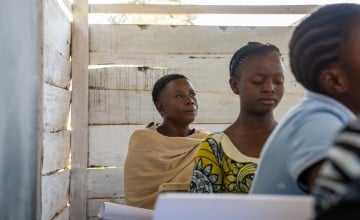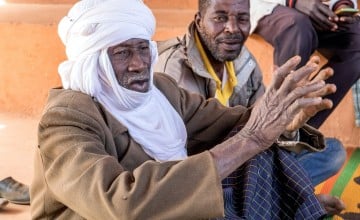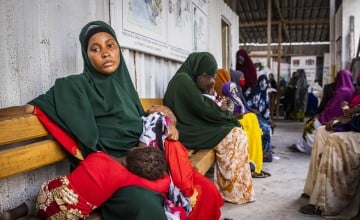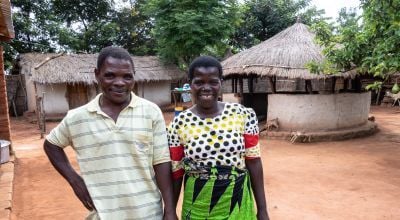
Read our 2024 annual report

Knowledge Hub
No country has reached full gender equality, an overall key element in eliminating poverty.
We can measure gender equality in a number of different ways, and track progress against a few key issues. These include gender-based violence (GBV), women’s participation in the workplace, representation at the political level, and maternal mortality rates. Many organisations are doing this work: the UN’s Human Development Index includes a gender component (now known as the Gender Development Index). Another key resource is the Women, Peace, and Security Index, published by Georgetown University and Oslo’s Peace Research Institute.
In these reports, many of the issues come down to one broad category: women’s rights. Which countries offer the most protections to gender equality? Which ones ensure that those protections are kept? Where is there still progress to be made?
Working with the most recent editions of both the GDI (2022-23) and WPS Index (2023-24), as well as available data from the World Economic Forum’s 2024 Global Gender Gap report, we’re updating our own list of the “worst” countries for women’s rights. The phrasing is subjective, but the benefits of fostering gender equality in each of these countries are clear.
1. Pakistan

Pakistan’s GDI score in 2023 was the tenth-lowest of all countries. While it ranks higher on the WPS index in 2024 (158 out of 177), it also ranks low in the World Economic Forum’s Gender Gap Index (161 out of 162).
Women and girls are especially vulnerable to the effects of natural disasters in the country, which are increasing in frequency and impact due to climate change. As the United Nations Development Programme (UNDP) reports, the country also has the lowest share of women in senior, managerial, and legislative roles (just 4.5%).
Gender equality in Pakistan is a core tenet of Concern’s work in the country. Our humanitarian programme Building Resilience and Addressing Vulnerabilities to Emergencies (BRAVE) has been developed with age, disability, and gender considerations that helped the initiative reach over 127,000 women and girls in 2024. Likewise, our ongoing response to the 2022 floods reached nearly 218,000 women.
2. Democratic Republic of the Congo

Like Pakistan, the Democratic Republic of the Congo ranks relatively high at number 31 on the UN’s latest GDI index. However, it places at 174 out of 177 on the WPS Index, amid increased conflict in the country’s eastern provinces. It also ranks as the worst country for intimate partner violence (36%), with half of all Congolese women over 15 reporting experiencing physical violence. As of 2024, only 12.8% of seats in parliament were held by women.
All of Concern’s initiatives in DRC include gender equality measures. This includes programmes specifically geared towards fostering gender equality, but even those tied to other sectors can lead to this goal. During one survey, we learned that women and girls in the area found it difficult to move around because of the risks they face, which led to poor sanitation and hygiene practices and a lack of clean water. By installing solar pumps in six drinking water supply systems, women and girls reported being able to stay closer to home and get the clean water they need.
3. Niger

Reducing gender inequality in Niger could increase per capita GDP by more than a fourth by 2030, according to the World Bank. Currently, the financial inclusion rate for women in the country is just over 10% according to the WPS Index, where it ranks 166 out of 177. It placed as the eighth-lowest county for gender equality on the UN’s GDI and also ranks low (138 out of 146) on the World Economic Forum’s index.
Women in Niger are especially vulnerable to violence on the basis of gender. The UN reports that over 76% of married women ages 20-24 were in that marriage before the age of 18. Adolescent birth rates are up, and nearly 13% of women ages 15-49 have reported recent attacks of sexual or physical violence by a current or former partner.
One way that we’re addressing gender equality in Niger is through Écoles de Maris, or schools for husbands. In partnership with Nigerien NGO Songes, we are supporting 50 such groups, with a total of 600 members, to engage men as allies for gender equality at the community level. They also partner with local religious leaders (in partnership with the regional Islamic Association) to show how religious texts support gender equality as well.
4. Syria

Syria ranks 171 out of 177 on the latest WPS Index, and has the sixth-lowest score on the most recent GDI. Both of these scores were taken before the political shifts at the end of 2024, and there are reasons to believe that there are more opportunities for political participation, legal reforms, and social change in the future. However, there is still a historical pattern of gender inequality (especially linked to conflict) that needs to be addressed. Last year’s WPS Index noted that 100% of Syrian women live within 50 kilometres of an active conflict zone.
Historically, Syria has also had low access to legal justice for women, and few laws protecting them against issues like sexual harassment in the workplace. Women are also less active in employment and financial sectors, in some cases by wide margins according to UN Women, and over 3.2 million girls need educational support.
Concern has been responding to the crisis in Syria since 2013, with a large part of our work focusing on supporting internally-displaced Syrian women and girls with access to emergency supplies, financial support and inclusion, and education for girls.
5. Iraq

Iraq ranks just below Syria on the latest GDI (with a score of 0.786) and the 10th lowest country on the WPS Index. One of the main issues reported in the country by the WPS is intimate partner violence, which 45% of Iraqi women reported experiencing within the last year — the highest on record.
Some gains have also been made, including a 29.2% representation in Parliament as of February 2024. However, other areas still require work, including the number of women and girls who are married before they turn 18, and the amount of unpaid domestic labour expected of women and girls (24%) compared to men (4%).
Concern’s primary work in Iraq centres on protection of civilians displaced by conflict, as well as access to water, sanitation, and hygiene, and gender equality considerations play a large role in both of these. As in Syria, we focus emergency support on families headed by women, who typically are more vulnerable and have less access to protection and other forms of humanitarian support. As we saw with DRC, WASH activities can also improve the safety and well-being of women and girls.
6. Somalia

Women and girls in Somalia face a multitude of challenges, leaving the country as fourth-to-last on the UN’s GDI and 169 out of 177 on the WPS Index. Early marriage rates have risen for women ages 20-24 in recent years, exceeding 45% in 2024. The United Nations Population Fund (UNFPA) also estimates that over 99% of Somali women and girls ages 15-49 have undergone female genital mutilation (FGM) — one of several forms of GBV that are statistical norms in the country. Parliamentary representation has also decreased, from 24% in 2016 to just over 19% in 2024.
7. Afghanistan

Afghanistan ranks second-to-last on the UN’s latest GDI with a score of 0.622 (second only to Yemen), and last on the WPS Index. Amid a protracted crisis that has left nearly 23 million people in need of humanitarian aid, women and girls continue to be among the most vulnerable in the country. They face severe restrictions on rights to work and education, which also impacts their access to aid and services. Since 2023, families headed by women have lost 40% of their income.
Gender-based violence is also a significant threat in the country, with over 50% of women ages 15-49 reporting experiencing a form of GBV at least once in their life. In some provinces, that rate climbs up to 92%. Women are also three times as likely to not have a bank account compared to men.
Concern’s EU-funded Advancing Women-led Agribusinesses to Reach Economic Empowerment (AWARE) programme has supported over 3,500 women working in agribusiness, including fruit, dairy, vegetable, saffron, and nuts, to advance their economic empowerment. Since the start of the programme, participants’ incomes have increased more than 15-fold, and collectively have accumulated over €92,000 for investment in expanding their businesses. Of the participants, 95% report improved confidence as a result of the programme.
8. South Sudan

While South Sudan was not included on the UN’s latest GDI, it does rank 173 out of 177 on the WPS Index. The country has made progress towards gender equality, with over 32% of seats in parliament held by women as of February 2024. However, South Sudanese women still lack many legal protections that should be a standard to mitigate against the risks of inequality, particularly those aimed at reducing violence against women. One in four women has experienced intimate partner violence in the last year, and over 51% of women ages 20-24 were married before their 18th birthday. Conflict contributes to these risks.
“The biggest problem in South Sudan is to change how society views the role of women and children because that is the root of it all,” says Elizabeth Henry, who runs the NGO Mother & Childcare.
Gender is a core theme for many of Concern’s programmes in South Sudan. Our ongoing emergency response in Unity State includes focuses on increasing equality and reducing the risk of GBV. We are also in the final year of a UNICEF-funded nutrition programme that will reach over 71,000 direct participants.
9. Central African Republic

Like South Sudan, the Central African Republic (which was ranked as one of the five worst countries to be a woman on previous Gender Inequality Indexes), has not been ranked on the most recent GDI. The WPS Index ranks it as 175 out of 177 countries, and the lowest-ranked country in sub-Saharan Africa.
The Women’s Peace and Humanitarian Fund reports that last year, more than two people (mostly women and girls) were victims of GBV every hour in the CAR, which also saw 11,000 cases reported in just the first six months of 2024. While the country has made progress in recent years, it still only has 11.4% of its parliamentary seats filled by women.
Concern CAR’s gender strategy includes projects that promote social cohesion, risk reduction, and gender-sensitive programming. As part of an EU-funded consortium, we provide support to GBV survivors via dignity kits and emergency PeP kits, as well as literacy courses (which have been proven to correlate with a decline in GBV risks). We’ve also helped to establish or revitalize local reconciliation and peace committees, which work at the community level to spread awareness about GBV and prevention. We do similar work with an Irish Aid-funded project via social cohesion community committees.
10. Yemen

Yemen ranks as 176 out of 177 on the WPS Index and, with a score of 0.456, last on the GDI. With a civil conflict in the country approaching its 10th anniversary, Yemeni women and girls are bearing a disproportionate amount of the impact, including compounded forms of GBV and restricted rights and activities. Just 6% of women in Yemen have either formal or informal work. The country also has the lowest average girls' education rates in the Middle East and North Africa — just 2.9 years. Women also hold less than half a percent of seats in Yemeni parliament.
Concern launched an emergency response in Yemen last year, primarily focusing on health and WASH services but ensuring that those services primarily meet the needs of women and children given the unique vulnerabilities they face. Last year, our health programmes in the country reached over 9,200 women with outpatient services, 862 women with antenatal care, and 260 women with postnatal care. Of the 17,500 people we reached in response to a new cholera outbreak within the country, over 12,000 were female.
Women’s rights: Your Concern in action
None of these issues can be fixed overnight or through policy change alone. Change and progress towards gender equality happens at the community, family, and even individual levels.
Yet we also see how deep the connections go between gender inequality and issues like poverty, hunger, conflict, and climate change. Concern specifically focuses on gender equality as a means to significantly reduce inequalities at large and reduce poverty within communities. It’s a key area of focus for all programmes in livelihoods, health and education in both development and humanitarian contexts.





